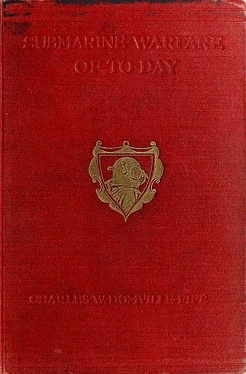The great auxiliary navy had to be built or obtained without depleting the ordinary mercantile fleets, and the shipbuilding and repairing yards, even in the smallest sea and river ports, worked day and night. The triumph was as wonderful as it was speedy. In less than fifteen months from August, 1914, the new navy was a gigantic force, and its operations extended from the Arctic Sea to the Equator. All units were armed, manned and linked up by wireless and a common cause.
Before this could be accomplished, however, the problem of maintaining this vast fleet and adequately controlling its operations had to be faced and overcome. The seas adjacent to the coasts of the United Kingdom, the Mediterranean Littoral and Colonial waters were divided into “patrol areas” on special secret charts, and each “area” had its own naval base, with harbour, stores, repairing and docking facilities, intelligence centre, wireless and signal stations, reserve of officers and men, social headquarters, workshops and medical department.
Each base was under the command of an admiral and staff, many of the former returning to duty, after several years of well-earned rest, as captains and commodores, with salaries commensurate with their reduced rank. Their staffs consisted of some six to twelve officers of the new navy, with possibly one or two from the “pukka service,” and their command often extended over many hundreds of square miles of submarine and mine infested sea.
Of these bases, which will be fully described in later chapters, there were about fifty, excluding the great dockyards and fleet headquarters, but inclusive of those situated overseas. When it is considered what a war base needs to make it an efficient rendezvous for some hundreds of ships and thousands of men, some idea of the gigantic task of organisation which their establishment, often in poorly equipped harbours and distant islands, required, not only in the first instance, but also with regard to maintenance and supplies, will be realised, perhaps, however, more fully when it is stated that the average ship needs a month spent in docking and overhauling at least once a year, and that the delicate and more speedy units of such a fleet need nearly four times that amount of attention.
One of the first requisites of the auxiliary navy was the creation of a headquarters staff at the Admiralty, London. This was formed from naval officers of experience both in the regular service and in the two reserves (R.N.R. and R.N.V.R.).
Forming an integral part of the great British or Allied armada, all operations were under the control of the Naval War Staff, but for purposes of more detailed organisation and administration additional departments were created which exercised direct jurisdiction over their respective fleets. The principal of these was known as the “Auxiliary Patrol Office,” under the Fourth Sea Lord and the Department of the Director of Minesweeping. These formed a part of the General Staff—if a military term is permissible—and both issued official publications periodically throughout the war, which served to keep the staffs of all the different war bases and the commanding officers of the thousands of ships informed as to current movements and ruses of the enemy.
It is unnecessary to detail more closely the work of these departments, especially as much has yet to be said before plunging into the maelstrom of war. A sufficient indication of the colossal nature of the work they were called upon to perform will be found in a moment’s reflection of what the administration and control of such a large and nondescript fleet, spread over the world—from the White Sea to the East Indies—must have meant to the small staff allowed by the exigencies of an unparalleled war.
The greatest problem in modern naval war is, undoubtedly, the supply of trained men. For this reason it has been left to the last to describe how the difficulty was faced and overcome by England and her oversea Dominions in 1914.
Before doing so, however, it may be of interest to give here a few extracts from an excellent little official publication, showing how the British fleet was manned and expanded in bygone days of national peril 1 1 Extract from Naval Demobilisation —issued by the Ministry of Reconstruction.
:
“In time of war there has always been an intimate connection between the Royal Navy and the Merchant Service. Latterly, and more especially since the Russian War of 1854 to 1856, this fact tended to be forgotten, partly because men-of-war developed on particular lines and became far more unlike merchantmen than they had ever been before, and also because, by the introduction of continuous service, the personnel of the Navy seemed to have developed into a separate caste, distinguished by its associations, traditions and esprit de corps , as much by its special training and qualifications, from other seafaring men. This war has proved once again, to such as needed proof, that the two services cannot exist without each other, and that the Sea Power of the Empire is not its naval strength alone, but its maritime strength. Even at the risk of insisting on the obvious, it is necessary to repeat that, for an Island Empire, a war at sea cannot be won merely by the naval action which defeats the enemy; naval successes are of value for the fruit they bear, the chief of which is the power that they give to the victor to maintain his own sea-borne trade and to interrupt that of the enemy.
“An elementary way of looking at the problems of manning the Royal Navy and the Merchant Service is to consider that there is in the country a common stock of seamen, on which both can draw. But this theory, like many others equally obvious and tempting, has the disadvantage that it leaves important factors out of account and, if worked out, results in an absurdity. Thus, shortly before war began there were in the country some 420,000 seamen, of whom one-third were in the Navy and two-thirds engaged in merchant ships and fishing vessels. There was no considerable body of unemployed seamen. During the war the personnel of the Navy was expanded to something like the 420,000 which represents the common stock of seamen. Therefore, if the theory met the case, there would have been no men left for the Merchant Service. But the merchant ships, in spite of difficulty and danger, continued to run, employing great numbers of men. And we must not forget to take into account the number of men, amounting to 48,000 killed and 4500 prisoners of war, who have been lost in the two services during the war. So it comes to this, that the common stock of seamen, or at least of men fit to man ships, has expanded during the war by more than 50 per cent. Whence came these extra men? Clearly for the most part from the non-seafaring classes.
“The Navy in November, 1918, employed some 80,000 officers and men from the Merchant Service—viz. 20,000 R.N.R. ratings, 36,000 Trawler Reserve, and 20,000 mercantile seamen and firemen on Transport agreements, plus the officers. If the supposition, made in the absence of statistics, is correct that at this time the number of men in the Merchant Service itself had decreased proportionately to the loss of tonnage, it would seem that the Merchant Service needed no considerable inflow of men during the war. In other words, most of those added to the stock of seamen during the war must have gone into the Navy. This corresponds with known fact: the Navy has, in addition to the Reserve men already mentioned, nearly 200,000 men to demobilise in order to put its personnel on the footing on which it stood when war broke out.
“It will be of interest to see how the personnel of the Navy expanded in former wars, and how at the peace it was invariably reduced to something like its pre-war figures. This can readily be done in tabular form:
Читать дальше












